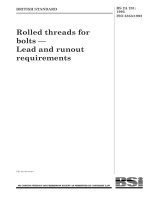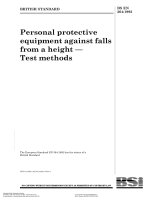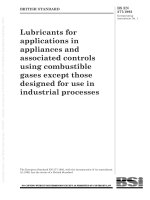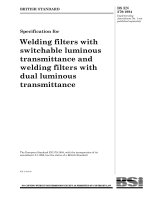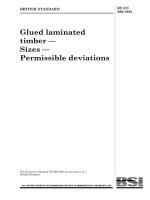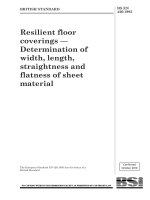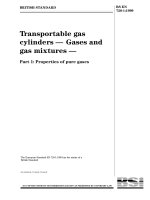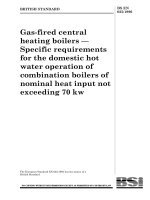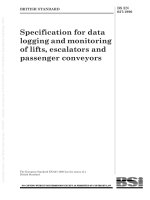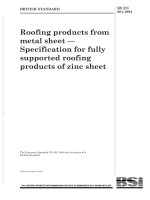Bsi bs en 00370 1993 (1999)
Bạn đang xem bản rút gọn của tài liệu. Xem và tải ngay bản đầy đủ của tài liệu tại đây (445.41 KB, 20 trang )
BRITISH STANDARD
Wood preservatives —
Determination of
eradicant efficacy in
preventing emergence
of Anobium punctatum
(De Geer)
The European Standard EN 370:1993 has the status of a
British Standard
UDC 74.048.4:620.193.87
BS EN
370:1993
BS EN 370:1993
Cooperating organizations
The European Committee for Standardization (CEN), under whose supervision
this European Standard was prepared, comprises the national standards
organizations of the following countries:
Austria
Belgium
Denmark
Finland
France
Germany
Greece
Iceland
Ireland
Italy
Luxembourg
Netherlands
Norway
Portugal
Spain
Sweden
Switzerland
United Kingdom
This British Standard, having
been prepared under the
direction of the Technical
Sector Board for Building
and Civil Engineering,
was published under the
authority of the Standards
Board and comes
into effect on
15 May 1993
© BSI 12-1999
The following BSI references
relate to the work on this
standard:
Committee reference B/515
Draft for comment 90/54561 DC
ISBN 0 580 21420 6
Oesterreichisches Normungsinstitut
Institut belge de normalisation
Dansk Standardiseringsraad
Suomen Standardisoimisliito, r.y.
Association franỗaise de normalisation
Deutsches Institut für Normung e.V.
Hellenic Organization for Standardization
Technological Institute of Iceland
National Standards Authority of Ireland
Ente Nazionale Italiano di Unificazione
Inspection du Travail et des Mines
Nederlands Normalisatie-instituut
Norges Standardiseringsforbund
Instituto Portugs da Qualidade
Asociación Espola de Normalización y Certificación
Standardiseringskommissionen i Sverige
Association suisse de normalisation
British Standards Institution
Amendments issued since publication
Amd. No.
Date
Comments
BS EN 370:1993
Contents
Cooperating organizations
National foreword
Foreword
Text of EN 370
National annex NA (informative) Committees responsible
National annex NB (informative) Cross-references
© BSI 12-1999
Page
Inside front cover
ii
2
3
Inside back cover
Inside back cover
i
BS EN 370:1993
National foreword
This British Standard has been prepared under the direction of the Technical
Sector Board for Building and Civil Engineering and is the English language
version of EN 370:1993 Wood preservatives — Determination of eradicant efficacy
in preventing emergence of Anobium punctatum (De Geer), published by the
European Committee for Standardization (CEN). EN 370:1993 was produced as
a result of international discussion in which the United Kingdom took an active
part.
CAUTION. Attention is drawn to the Health and Safety at Work etc. Act 1974,
and a need for ensuring that the method specified in this British Standard is
carried out with suitable precautions.
The procedure described in this British Standard is intended to be carried out by
appropriately qualified and experienced persons or other suitably trained and/or
supervised personnel. Attention is drawn to the precautions given in the
introduction and 5.3.2.
A British Standard does not purport to include all the necessary provisions of a
contract. Users of British Standards are responsible for their correct application.
Compliance with a British Standard does not of itself confer immunity
from legal obligations.
Summary of pages
This document comprises a front cover, an inside front cover, pages i and ii,
the EN title page, pages 2 to 14, an inside back cover and a back cover.
This standard has been updated (see copyright date) and may have had
amendments incorporated. This will be indicated in the amendment table on the
inside front cover.
ii
© BSI 12-1999
EUROPEAN STANDARD
EN 370
NORME EUROPÉENNE
April 1993
EUROPÄISCHE NORM
UDC 74.048.4:620.193.87
Descriptors: Wood, wood preservatives, insecticides, pesticides, pest control, laboratory tests, determination, effectiveness, anobiidae
English version
Wood preservatives — Determination of eradicant efficacy
in preventing emergence of Anobium punctatum (De Geer)
Produits de préservation du bois —
Détermination de l’efficacité curative contre
l’émergence d’Anobium punctatum (De Geer)
Holzschutzmittel — Bestimmung der auf
Schlupfverhinderung beruhenden
bekämpfenden Wirksamkeit gegenüber
Anobium punctatum
(De Geer)
This European Standard was approved by CEN on 1993-03-31. CEN members
are bound to comply with the CEN/CENELEC Internal Regulations which
stipulate the conditions for giving this European Standard the status of a
national standard without any alteration.
Up-to-date lists and bibliographical references concerning such national
standards may be obtained on application to the Central Secretariat or to any
CEN member.
This European Standard exists in three official versions (English, French,
German). A version in any other language made by translation under the
responsibility of a CEN member into its own language and notified to the
Central Secretariat has the same status as the official versions.
CEN members are the national standards bodies of Austria, Belgium,
Denmark, Finland, France, Germany, Greece, Iceland, Ireland, Italy,
Luxembourg, Netherlands, Norway, Portugal, Spain, Sweden, Switzerland and
United Kingdom.
CEN
European Committee for Standardization
Comité Européen de Normalisation
Europäisches Komitee für Normung
Central Secretariat: rue de Stassart 36, B-1050 Brussels
© 1993 Copyright reserved to CEN members
Ref. No. EN 370:1993 E
EN 370:1993
Foreword
This European Standard was drawn up by the
“Anobium” Expert Group of CEN/TC 38 “Durability
of wood and wood-based products”, the secretariat of
which is held by AFNOR.
The method is new and has been developed to assess
the efficacy of eradicant formulations based on
non-penetrating fluids which act only on emerging
adult beetles and not at depth on larvae established
in the wood.
This European Standard shall be given the status
of a national standard, either by publication of
an identical text or by endorsement, at the latest by
October 1993, and conflicting national standards
shall be withdrawn at the latest by October 1993.
This European Standard has been approved by
CEN and in accordance with the Common
CEN/CENELEC Rules, the following countries are
bound to implement this European Standard:
Austria, Belgium, Denmark, Finland, France,
Germany, Greece, Iceland, Ireland, Italy,
Luxembourg, Netherlands, Norway, Portugal,
Spain, Sweden, Switzerland and United Kingdom.
2
Contents
Foreword
Introduction
1 Scope
2 Normative references
3 Definitions
4 Principle
5 Test materials and apparatus
6 Sampling
7 Test specimens
8 Procedure
9 Validity of test
10 Expression of results
11 Test report
Annex A (informative) Example
of a test report
Annex B (informative) Culturing for
technique of Anobium punctatum
Annex C (informative) Bibliography
Figure 1a — Number and distribution
of test specimens taken from three
different trees of the same species
Figure 1b — Origin and cutting
of the test specimen
Figure 2 — Preparation of subspecimens
Figure 3 — Distribution of holes
in subspecimens
Table 1 — Numbers of larvae
Table A.1 — Results
Page
2
3
3
3
3
3
3
4
4
5
7
7
7
11
12
13
8
9
10
10
4
11
© BSI 12-1999
EN 370:1993
Introduction
2 Normative references
This European Standard describes a laboratory
method of test which gives a basis for assessment of
the eradicant efficacy of a wood preservative, in
preventing emergence of Anobium punctatum. It
determines the lethal effects, of an insecticidal
product, deposited by surface application, on beetles
attempting to emerge through treated wood
surfaces.
The method simulates conditions which can appear
in practice where a length of timber infested with
Anobium punctatum is treated on all the sides from
which emergence of beetles is possible.
This laboratory method provides one criterion by
which the value of a product can be assessed. In
making this assessment the methods by which the
preservative may be applied should be taken into
account. It is further recommended that results
from this test should be supplemented by those from
other appropriate tests, and above all by comparison
with practical experience.
When products which are very active at low
concentrations are used it is very important to take
suitable precautions to isolate and separate, as far
as possible, operations involving chemical products,
other products, treated wood, laboratory apparatus
and clothing. Suitable precautions should include
the use of separate rooms, areas within rooms,
extraction facilities, conditioning chambers and
special training for personnel.
This European Standard incorporates by dated or
undated reference, provisions from other
publications. These normative references are cited
at the appropriate places in the text and the
publications are listed hereafter. For dated
references, subsequent amendments to or revisions
of any of these publications apply to this European
Standard only when incorporated in it by
amendment or revision. For undated references the
latest edition of the publication referred to applies.
ISO 835-1:1981, Laboratory glassware —
Graduated pipettes — Part 1: General requirements.
ISO 3696:1987, Water for analytical laboratory
use — Specification and test methods.
1 Scope
Preservative is applied by brush or pipette into test
specimens of a susceptible timber. After drying the
test specimens are cut into two subspecimens and
larvae of Anobium punctatum are introduced into
the freshly-cut end grain surfaces.
After allowing larvae to establish, the untreated
faces are sealed and insects are induced to pupate
and emerge. The numbers of beetles that emerge
and the population that remains within the
specimens are compared with those in untreated
controls.
This European Standard specifies a method for the
determination of the curative action of a wood
preservative against infestation by Anobium
punctatum (De Geer) when the product is applied as
a surface treatment to wood.
This method is applicable to any surface applied
treatment that is intended to prevent emergence of
adult beetles but not intended to kill larvae in
infested timber.
NOTE 1 This method may be used in conjunction with an
ageing procedure, for example EN 73.
NOTE 2 Products intended to kill larvae should be tested by the
method described in EN 48.
3 Definitions
For the purposes of this standard, the following
definitions apply.
3.1
representative sample
a sample having its physical or chemical
characteristics identical to the volumetric average
characteristics of the total volume being sampled
3.2
supplier
the sponsor of the test
4 Principle
5 Test materials and apparatus
5.1 Biological material
5.1.1 Anobium punctatum (De Geer) larvae
NOTE The culturing technique, which experience has shown to
be suitable, is described in Annex B.
5.1.2 Provision of larvae
Carefully split or crumble infested small
branchwood to extract larvae. Examine them under
a binocular miscroscope and destroy any that show
injury or mite infestation or that do not respond by
movement when touched.
© BSI 12-1999
3
EN 370:1993
Weigh the larvae and keep those that have a mass
between 7 mg and 12 mg, and are in perfect
condition. Keep them, for between 12 h and 60 h,
separately from one another in glass receptacles in
the culturing chamber (5.3.1). Re-examine them
and reject any which do not show movement in
response to stimulation with a fine brush.
5.1.3 Choice of larvae
Select sets of 12 larvae so that the total mass of each
set is between 100 mg and 125 mg.
The numbers of larvae required are shown in
Table 1.
Table 1 — Numbers of larvae
Number of test specimens
(100 mm × 50 mm × 30 mm)
Number of
required
formulations
to be tested
Untreated
Treated
controls
specimens
1
2
3
4
3
8
6
6
3
6
9
12
Total
number of
larvae
required
144
216
360
432
NOTE Additional larvae may be required to replace larvae
which do not establish in the test subspecimens.
or:
ventilated and controlled at (6 ± 1) °C and
relative humidity (70 ± 5) %.
5.3.5 Drill, provided with bits capable of drilling
smooth cylindrical holes of 2 mm diameter in wood.
5.3.6 Plastics plates, of opaque unplasticized
PVC, 50 mm × 30 mm × 1 mm.
5.3.7 Safety equipment and protective clothing,
appropriate for the test product and the test solvent,
to ensure the safety of the operator.
5.3.8 Pipette, of type specified in ISO 835-1,
class B: graduated pipette with no waiting time.
Capacity from 0,5 ml to 25 ml with an accuracy
of ± 0,01 ml.
5.3.9 Ordinary laboratory equipment, including a
balance capable of weighing to an accuracy of 0,01 g.
6 Sampling
The sample of preservative shall be representative
of the product to be tested. Samples shall be stored
and handled in accordance with any written
recommendations from the supplier.
NOTE For the sampling of preservatives from bulk supplies,
the procedure given in EN 212 should be used.
5.2 Products and reagents
7 Test specimens
5.2.1 Water, complying with grade 3 of ISO 3696.
5.2.2 Gelatin, for sealing the relevant surfaces of
specimens to be treated with solutions in which an
organic solvent is the continuous phase.
5.2.3 Paraffin wax, for sealing the relevant surfaces
of specimens to be treated with solutions in which
water is the continuous phase.
7.1 Species of wood
NOTE Paraffin wax with a setting point of 52 °C to 54 °C has
been found to be suitable.
Use only sound sapwood, straight-grained and
without knots and bark.
The wood shall have an average growth of between
two annual growth rings per 10 mm and eight
annual growth rings per 10 mm (two annual growth
rings per 10 mm to six annual rings per 10 mm for
beech).
5.3 Apparatus
5.3.1 Culturing chamber, with air circulation,
controlled at (21 ± 1) °C, and at relative
humidity (80 ± 5) %.
5.3.2 Laboratory work area, well ventilated, where
treatment of the test specimens is carried out.
CAUTION. It is essential to follow safety procedures
for handling flammable and toxic materials. Avoid
excessive exposure of operators to solvents or their
vapours.
5.3.3 Testing chamber, ventilated, controlled
at (21 ± 1) °C and at relative humidity (70 ± 5) %.
5.3.4 Low temperature regime chamber, either:
ventilated and controlled to provide a continuous
temperature regime with consecutive cycles
of 12 h at (6 ± 1) °C and 12 h at (13 ± 1) °C;
4
The test shall be carried out on Pinus sylvestris
(Linnaeus) European redwood, Scots pine.
NOTE Additional tests may be made with other species such as
beech (Fagus sylvatica) (Linnaeus) but, if so, this should be stated
in the test report.
7.2 Quality of wood
NOTE 1 It is recommended to use test specimens of similar
growth rate within a single test.
Only sapwood with a low resin content shall be used.
The proportion of summer wood in the annual rings
shall not exceed 30 % of the whole.
The wood shall have been neither floated nor
subjected to chemical or heat treatment. It shall be
air dried and shall not have been stored for more
than five years.
NOTE 2
Gentle artificial drying at below 60 °C may be used.
© BSI 12-1999
EN 370:1993
7.3 Provision of test specimens
Select the test specimens (which are subsequently
cut into two subspecimens) for each test from three
trees. For each test the test specimens from each
tree shall all be selected from within a 1 m length of
the tree measured in the direction of the grain.
Select the specimens as shown in Figure 1a.
Cut the test specimens from scantlings or beams, so
that, on the transverse cross section, the annual
growth rings form an angle of 45° ± 10° with the
longitudinal faces (see Figure 1b).
The test specimens shall be planed.
7.4 Dimensions of test specimens
The dimensions of each test specimen, measured
at 12 % (m/m) moisture content shall be:
(100 ± 0,5) mm × (50 ± 0,5) mm × (30 ± 0,5) mm
NOTE Moisture meters of the two-pronged electrical
conductivity type are suitable for assessing moisture content.
Mark each specimen so that it can be identified
throughout the test.
7.5 Number of test specimens
Use, for a single preservative, applied at a single
concentration, by a single method of treatment:
— 3 treated test specimens (one per tree);
— 3 untreated control specimens (one per tree).
If the examination involves several preservatives,
concentrations or methods of treatment at the same
time, three untreated control specimens shall be
used for two sets of three treated test specimens
(see Figure 1a).
8 Procedure
8.1 Preparation of the test specimens
8.1.1 Sealing of the transverse faces
Seal the transverse cross sections:
8.1.1.1 For tests with solutions in which water is the
continuous phase, apply three coats of the paraffin
wax (5.2.3) at about 90 °C so that the first coat
adheres closely to the wood and the successive
coatings bond to one another.
8.1.1.2 For tests with preservative solutions in
which the continuous phase is an organic solvent
that dissolves paraffin wax, use the gelatin (5.2.2);
apply the first coat with an aqueous solution
of 200 g/l at 40 °C, then after a minimum of 8 h of
drying, apply two further coats of an aqueous
solution of 300 g/l at 50 °C.
8.1.2 Treatment of test specimens
8.1.2.1 Preparation of treatment solution
8.1.2.1.1 Solid preservatives: water soluble
preservatives
© BSI 12-1999
Dissolve the preservative in the water (5.2.1) to the
required concentrations.
8.1.2.1.2 Liquid preservatives
If appropriate, use the preservative without further
preparation other than any necessary stirring. If it
is a concentrate, dilute it with the diluent to the
required working concentration, using the
procedure specified by the supplier.
All treatment solutions shall be freshly prepared.
8.1.2.2 Application of the treatment solution
Determine the actual area of each unsealed surface
to be treated taking into account any possible
encroachment of the sealing compound.
NOTE 1
The area to be treated is theoretically 160 cm2.
Determine the volumes or masses of the treatment
solution (8.1.2.1) to be applied to each unsealed face
to give the application rate specified by the supplier.
NOTE 2 The quantity of treatment solution to be applied
should be realistic in view of the field of application and the
supplier’s instructions. Normally the quantity should not
exceed 250 g/m2.
In the laboratory work area (5.3.2), using either the
pipette (5.3.8) or a brush, apply respectively the
calculated volume or mass of the treatment
solution (8.1.2.1) to each of the unsealed faces as
uniformly as possible and measured to the
nearest 0,01 ml or 0,01 g. When applying by
pipette (5.3.8) use pen-like zig-zag movements
across each surface. Apply the treatment solution to
each face whilst keeping that face in a horizontal
and upward facing position. Allow any surface
liquid to be absorbed into each face before treating
the next face.
NOTE 3 If the required quantity cannot be applied in one
application the treatment solution may be applied in successive
applications at appropriately close intervals so as to avoid
solidification of any substances hindering the penetration of the
subsequent applications.
If brush application is used, weigh the specimens
before and immediately after each brush application
to determine the mass applied.
From the quantity of treatment solution applied to
each face of each treated test specimen, determine
and record the application rate in grams per square
metre (brush application) or millilitres per square
metre (pipette application) of the treated test
specimens.
8.1.2.3 Conditioning of the test specimens after
treatment
After treatment, condition the specimens for four
weeks in the laboratory work area (5.3.2). Arrange
the specimens on their narrow faces, resting on
glass rods, not touching one another. Invert the
specimens twice a week.
5
EN 370:1993
If the test specimens shall be subjected to an ageing
procedure (e.g. EN 73) this shall be carried out after
this conditioning procedure.
8.2 Exposure of the test specimens to the
insects
8.2.1 Preparation of subspecimens
Cross-cut each specimen, at its centre as shown in
Figure 2. Then cross-cut each piece to remove the
sealed transverse face to give a subspecimen 45 mm
long.
8.2.2 Insertion of larvae
Keep all the subspecimens in the testing
chamber (5.3.3) for two weeks before drilling the
holes to take the larvae.
Using the drill (5.3.5), drill six cylindrical holes
approximately 8 mm deep in the two transverse
cross sections of each subspecimen. Drill a pattern
of holes in two lines of three, 10 mm from the large
faces of the subspecimen with a distance between
the holes in the same row of 15 mm and a distance
between the two rows of 10 mm (see Figure 3).
Insert the selected larvae head first, one into each of
the 12 holes of each of the six treated subspecimens
(derived from the three treated specimens) and six
untreated control subspecimens, (derived from
three untreated control specimens).
Close the entrances to the holes by means of 2 glass
plates and fix these to the test subspecimen by
means of a narrow adhesive tape or elastic rubber
bands.
NOTE 1 Ordinary microscope slides have been found suitable
for use as glass plates.
NOTE 2 It is also possible to insert the larvae in two stages.
First, larvae are inserted in one end only of each subspecimen
and the subspecimens are left for one week with the ends
containing the larvae uppermost. After one week, the
subspecimens are inverted and the larvae are inserted into the
second end.
Keep the subspecimens in the testing
chamber (5.3.3) for one week, placing them on one of
their wider lateral faces. At the end of this period
remove the glass plates to establish whether
individual larvae have tunnelled into the test
subspecimens. Actively tunnelling larvae will have
obscured the hole entrances with excreted frass.
Replace any larvae which do not start boring then
seal the end grain surfaces with opaque plastics
plate (5.3.6) affixed with an adhesive containing no
ingredients or solvents which would have a toxic
effect on the insects.
NOTE 3 Latex rubber solution or gelatine solution have been
found to be suitable.
6
8.2.3 Conditioning of infested subspecimens to
induce emergence
Keep the subspecimens, complete with larvae, in the
testing chamber (5.3.3) for a further three weeks.
Then place the subspecimens in a low temperature
regime chamber (5.3.4) to stimulate pupation of
larvae.
NOTE 1 The following regimes have been found to produce
adequate levels of pupation in certain countries, either:
10 weeks at (6 ± 1) °C, or;
10 weeks of a regime of 12 hours at (6 ± 1) °C
followed by 12 hours at (13 ± 1) °C.
NOTE 2 Other low temperature regimes may also be used
provided that they produce emergence from untreated controls
which complies with the criteria for the validity of the test
(clause 9).
At the end of the low temperature regime replace
the subspecimens in the testing chamber (5.3.3).
8.3 Examination of subspecimens
Examine the subspecimens each week to establish
the number of exit holes or emerged beetles. Remove
and record any beetles found. Emergence may begin
from 8 to 16 weeks after removal from the low
temperature regime and usually lasts two to
four weeks.
When no further beetles or exit holes have been
observed for four weeks, record the total number of
exit holes on each subspecimen. If less than 30 of the
insects in the untreated control subspecimens from
a test of a single product have emerged 24 weeks
after removal of the subspecimens from the low
temperature regime then repeat the low
temperature regime on both the treated and
untreated subspecimens. Also repeat the
examination procedure at weekly intervals until no
further beetles have been observed for four weeks.
Record the start of emergence and the number of
cycles of the low temperature regime.
Record the numbers of beetles emerging from each
treated subspecimen and each untreated control
subspecimen and the number of exit holes on each
subspecimen.
Record the number of larvae and beetles retrieved
by cutting up each subspecimen at the end of the
test, separating them into:
— dead or moribund larvae or pupae;
— live larvae or pupae;
— dead or moribund beetles;
— live beetles.
Determine and record the number of insects not
recovered.
© BSI 12-1999
EN 370:1993
9 Validity of the test
The test shall be considered valid if for a test of a
single product at least 30 of the larvae placed in
the untreated control subspecimens have emerged
as adult beetles.
10 Expression of results
The results shall be expressed in the terms given
in 8.3. The eradicant efficacy shall be assessed by
comparison of the numbers of beetles emerging
from, and the population remaining in, the treated
subspecimens with the numbers emerging from,
and the population remaining in, the untreated
subspecimens as recorded in 8.3.
11 Test report
The test report shall include at least the following
information (see also Annex A for an example):
a) the number and date of this European
Standard;
b) the name of the supplier of the preservative
under test;
c) the specific and unique name or code of the
preservative tested, with an indication of
whether or not the composition has been
declared;
d) if relevant, the solvent or diluent used;
e) the species of wood used;
f) the concentration of preservatives tested,
expressed as percentages by mass;
g) the method of application and number of coats
of preservative applied;
h) the amount of product applied to the treated
surface in grams per square metre and millilitres
per square metre;
© BSI 12-1999
i) the date of the application of the preservative;
j) any ageing procedures carried out, specifying
the type, conditions and duration, with possible
reference to a standard;
k) the date of insertion of larvae;
l) the date(s) of examination of the subspecimens;
m) the date of first emergence of beetles and the
number of low temperature regimes;
n) the results of the examination of each treated
subspecimen and each control subspecimen:
— number of adults emerged from the wood;
— number of exit holes in the sealed and
unsealed surfaces;
— number of insects found, dividing them into:
living i) adult beetles, ii) larvae and iii)
pupae
dead i) adult beetles, ii) larvae and iii)
pupae
number of unrecovered insects.
o) the name of the organization responsible for
the test report and the date of issue;
p) the name and signature of the officer(s) in
charge of testing;
q) the following note:
“The interpretation and the practical
conclusions that can be drawn from this test
report demand a specialized knowledge of the
subject of wood preservation and, for this
reason, this test report cannot of itself
constitute an approval certificate”.
The test report shall list any variation from the
described test method and any factors that may
have influenced the results.
7
EN 370:1993
Figure 1a — Number and distribution of test specimens taken from
three different trees of the same species
8
© BSI 12-1999
EN 370:1993
Figure 1b — Origin and cutting of the test specimen
© BSI 12-1999
9
EN 370:1993
Figure 2 — Preparation of subspecimens
Figure 3 — Distribution of holes in subspecimens
10
© BSI 12-1999
EN 370:1993
Annex A (informative)
Example of a test report
— Number and date of this European Standard
— Name of supplier
— Name and type of preservative
: EN 370:1993
: company S
: X-emulsion formulation, ready for use, composition
not declared
: None
: Pinus sylvestris (Linnaeus)
: preservative used undiluted
: brushing: two coats in 24 h
— Solvent or diluent used
— Species of wood used
— Concentration of the preservative tested
— Type of treatment and number of applications
— Average quantity of preservative applied
to each test specimen
— Date of application
— Date of insertion of larvae
— Date of examination
— Date of first emergence of beetles
— Number of low temperature regimes
— Results
This report has been prepared by the
Location and date
Name and signature of the officer(s) in charge
: 250 g/m2
: 1985.10.22
: 1985.12.03
: 1986.08.20
: 1986.06.25
:1
: see Table A.1
: laboratory L
: X 1986.11.17
: Mrs Y
NOTE The interpretation and the practical conclusions that can be drawn from this test report demand a specialized knowledge of
the subject of wood preservation and, for this reason, this test report cannot of itself constitute an approval certificate.
Table A.1 — Results
Type and
number of
subspecimen
Number of
insects
recovered
Number
of exit
holes
Number of
adult beetles
emerged
Number of
insects not
recovered
Condition of insects recovered by cutting
subspecimens
Live
Dead
Adults Pupae Larvae Adults Pupae Larvae
Treated
1
2
3
4
5
6
12
11
12
12
12
11
1
0
1
2
0
0
1
0
1
2
0
0
0
1
0
0
0
10
0
0
0
0
0
0
0
0
0
0
0
0
3
3
2
1
3
4
7
6
6
8
8
7
0
0
0
0
0
0
0
2
2
1
1
0
Total
70
4
4
20
0
0
16
42
0
6
Untreated controls
1
2
3
4
5
6
12
12
11
12
12
12
6
5
8
7
6
4
6
5
8
7
6
4
0
0
1
0
0
0
0
0
0
0
0
0
0
0
0
0
0
0
4
6
1
3
5
6
2
1
1
1
0
1
0
0
0
0
0
0
0
0
1
1
1
1
Total
71
36
36
1
0
0
25
6
0
4
© BSI 12-1999
11
EN 370:1993
Annex B (informative)
Culturing technique for Anobium punctatum
B.1 Culture wood
B.1.1 Wood species
Oak (Quercus sp.) or hazel (Corylus avellana).
NOTE
Other European hardwoods may also be used if experience of their suitability is available.
NOTE
After four weeks in culturing conditions dead adult beetles may be removed.
NOTE
After 18 months in the conditions described in B.4.1, the majority of larvae should exceed a mass of 7 mg.
B.1.2 Collection of culture wood
Use only small branchwood felled in the winter and containing a high proportion of sapwood.
B.1.3 Cutting of culture wood
Strip bark from larger stems (30 mm diameter) and cross cut to lengths of approximately 150 mm. Stems
may be split lengthwise to facilitate drying.
B.1.4 Drying of culture wood
Dry as rapidly as possible by placing in a stream of air not exceeding 40 °C.
B.2 Source of beetles
B.2.1 Collection of beetles
Obtain freshly emerged adult beetles of Anobium punctatum from naturally infested material. Do not bring
naturally infested material into the vicinity of the laboratory or culturing areas.
Moisten naturally infested material occasionally.
During the summer emergence period, take daily collections of beetles from the surfaces of the infested
wood, tapping gently to remove beetles from their exit holes.
B.2.2 Quarantine of beetles
Place one filter paper sheet vertically into a large glass jar and then introduce the collected adult beetles.
Place a lid or gauze covering on the jar.
Keep the jar remote from the culturing area for 24 h and then remove the filter paper with attached beetles.
The attached beetles may be used for culturing. The jar should be sterilized and the remaining beetles
destroyed.
B.3 Infestation of culture wood
B.3.1 Culture vessels
Glass jars large enough to contain the pieces of wood (B.3.2) stood in a vertical position.
B.3.2 Preparation of wood
The pieces of wood may be utilized with sawn and split surfaces only, or with muslin mesh of 0,3 mm
to 0,5 mm fixed on to one end grain surface using sodium carboxymethylcellulose glue (food quality).
Alternatively egg-laying sites may be provided by artificially roughening or scoring the surface of the wood.
B.3.3 Introduction of beetles
Place the pieces of wood vertically in jars with, where appropriate, muslin-coated ends uppermost.
Introduce one pair of adult beetles for every 15 cm3 to 20 cm3 wood (approximately).
Cover the jar tops with an air-permeable material, e.g. muslin (aperture approximately 0,8 mm) or filter
paper to prevent escape of beetles.
B.4 Culturing conditions
B.4.1 Normal environment
The normal culturing conditions are obtained in introducing the culture vessels with the infested
wood (B.3.3) into the culturing chamber (5.3.1).
B.4.2 Natural pupation induction
After a minimum of 18 months in conditions as in B.4.1, place the culturing jars in an unheated insectary
from mid-November to mid-March, and then return to conditions as in B.4.1. Emergence can be expected
after a delay of several months.
12
© BSI 12-1999
EN 370:1993
B.4.3 Artificial pupation induction
It is possible to induce pupation and emergence by means of a period of refrigeration of the infested wood
at 7 °C for between 60 days and 80 days. However with some sources of insects it has been found necessary
to simulate artificially the varying outside temperature conditions for early spring time to achieve
adequate emergence. By both means it is also possible to obtain emergence of beetles out-of-season or
throughout the year.
B.5 Collection of beetles
Inspect cultures daily and remove adult beetles by tapping the wood samples. Reinfestation to achieve a
second generation may be possible in the culture wood.
Furthermore, material can be used more readily as a source of larvae for test work by crumbling or splitting
the infested samples.
B.6 General culture hygiene
Special precautions and strict adherence to them is necessary to avoid infestations of parasites, mainly
mites of the genus Pyemotes or Hymenoptera such as Theocolax formiciformis or Spathius exarator.
The parasitic mites Pyemotes spp. and other species can be very troublesome, especially under conditions
of incubation. These mites are frequently present in wood with a natural Anobium infestation and it is
essential not to bring naturally infested wood into the room or incubators where tests are carried out.
Important precautions are:
— prohibit introduction of unsterilized naturally infested wood into laboratory or culturing areas;
— avoid transfer of mites from naturally infested wood by changing clothing before and after working
with cultures. After contact with naturally infested material, staff should avoid contact with clean
cultures for 24 h;
— keep culture jars isolated from each other in shallow trays of water containing a small quantity of
detergent;
— keep adult beetles collected for tests or for re-culturing overnight in closed petri dishes with
paper-lined bottoms (10 insects per dish). The following day examine the insects and discard any which
seem damaged or inactive.
Annex C (informative)
Bibliography
EN 48:1988, Wood preservatives — Determination of the eradicant action against larvae of Anobium
punctatum (De Geer) (laboratory method).
EN 73:1988, Wood preservatives — Accelerated ageing of treated wood prior to biological testing —
Evaporative ageing procedure.
EN 212:1986, Wood preservatives — Guide to sampling and preparation of wood preservatives and treated
timber for analysis.
© BSI 12-1999
13
14
blank
BS EN 370:1993
National annex NA (informative)
Committees responsible
The United Kingdom participation in the preparation of this European Standard was entrusted by the
Technical Sector Board for Building and Civil Engineering (B/-) to Technical Committee B/515, upon which
the following bodies were represented:
British Wood Preserving and Damp-proofing Association
Chemical Industries’ Association
Creosote Council
Department of the Environment (Building Research Establishment)
Electricity Industry in United Kingdom
Institute of Wood Science
National House-building Council
Timber Research and Development Association
Timber Trade Federation
The following bodies were also represented in the drafting of the standard, through subcommittees and
panels:
Association of Consulting Scientists
Imperial College of Science and Technology
National annex NB (informative)
Cross-references
Publication referred to
Corresponding British Standard
EN 48:1988
BS 5436:1989 Wood preservatives and determination of eradicant action against
larvae of Anobium punctatum (De Geer) (laboratory method)
BS 5761 Wood preservatives. Accelerated ageing of treated wood prior to
biological testing
Part 1:1989 Evaporative ageing procedure
BS 5666 Methods of analysis of wood preservatives and treated timber
Part 1:1987 Guide to sampling and preparation of wood preservatives and treated
timber for analysis
BS 700 Graduated pipettes
Part 1:1982 Specification for general requirements
BS 3978:1987 Specification for water for laboratory use
EN 73:1988
EN 212:1986
ISO 835-1:1981
ISO 3696:1987
© BSI 12-1999
BS EN
370:1993
BSI — British Standards Institution
BSI is the independent national body responsible for preparing
British Standards. It presents the UK view on standards in Europe and at the
international level. It is incorporated by Royal Charter.
Revisions
British Standards are updated by amendment or revision. Users of
British Standards should make sure that they possess the latest amendments or
editions.
It is the constant aim of BSI to improve the quality of our products and services.
We would be grateful if anyone finding an inaccuracy or ambiguity while using
this British Standard would inform the Secretary of the technical committee
responsible, the identity of which can be found on the inside front cover.
Tel: 020 8996 9000. Fax: 020 8996 7400.
BSI offers members an individual updating service called PLUS which ensures
that subscribers automatically receive the latest editions of standards.
Buying standards
Orders for all BSI, international and foreign standards publications should be
addressed to Customer Services. Tel: 020 8996 9001. Fax: 020 8996 7001.
In response to orders for international standards, it is BSI policy to supply the
BSI implementation of those that have been published as British Standards,
unless otherwise requested.
Information on standards
BSI provides a wide range of information on national, European and
international standards through its Library and its Technical Help to Exporters
Service. Various BSI electronic information services are also available which give
details on all its products and services. Contact the Information Centre.
Tel: 020 8996 7111. Fax: 020 8996 7048.
Subscribing members of BSI are kept up to date with standards developments
and receive substantial discounts on the purchase price of standards. For details
of these and other benefits contact Membership Administration.
Tel: 020 8996 7002. Fax: 020 8996 7001.
Copyright
Copyright subsists in all BSI publications. BSI also holds the copyright, in the
UK, of the publications of the international standardization bodies. Except as
permitted under the Copyright, Designs and Patents Act 1988 no extract may be
reproduced, stored in a retrieval system or transmitted in any form or by any
means – electronic, photocopying, recording or otherwise – without prior written
permission from BSI.
This does not preclude the free use, in the course of implementing the standard,
of necessary details such as symbols, and size, type or grade designations. If these
details are to be used for any other purpose than implementation then the prior
written permission of BSI must be obtained.
BSI
389 Chiswick High Road
London
W4 4AL
If permission is granted, the terms may include royalty payments or a licensing
agreement. Details and advice can be obtained from the Copyright Manager.
Tel: 020 8996 7070.
